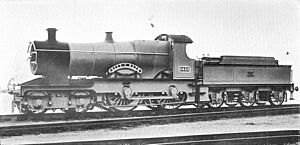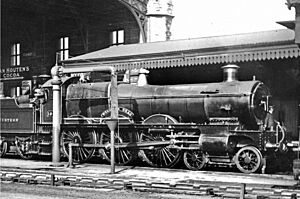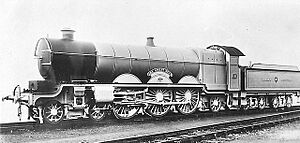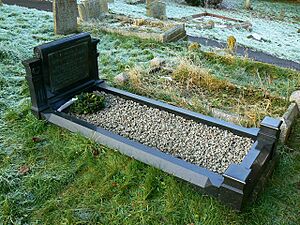George Jackson Churchward facts for kids
Quick facts for kids
George Jackson Churchward
|
|
|---|---|
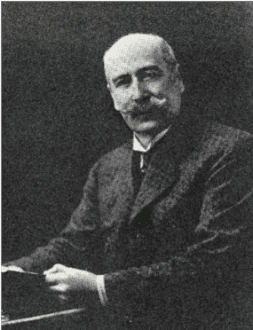 |
|
| Born | 31 January 1857 Stoke Gabriel, Devon, England
|
| Died | 19 December 1933 (aged 76) |
| Occupation | Mechanical engineer |
| Awards | CBE |
George Jackson Churchward (born January 31, 1857 – died December 19, 1933) was a famous English railway engineer. He was the main engineer for the Great Western Railway (GWR) in the United Kingdom from 1902 to 1922. He designed many important steam locomotives that changed how trains were built in Britain for a long time.
Contents
Early Life and Training
George Churchward was born on a farm in Stoke Gabriel, Devon, England. His family had lived there for many years. He went to the King Edward VI Grammar School in Totnes.
In 1871, he started learning to be an engineer. He trained with John Wright, who was in charge of locomotives for several railway companies. While training, George and a friend even built a steam-powered car using parts from a fire engine!
Starting His Career
When the GWR took over the South Devon Railway in 1876, Churchward moved to the Swindon Works. This was a big workshop where trains were built and repaired. After finishing his training, he joined the drawing office. There, he helped develop a new type of brake for trains.
He quickly moved up in the company. He became an Inspecting Engineer in 1882. Then, he became the manager of the Carriage Works, which built train carriages. Later, he became the manager of the locomotive works, where the engines themselves were built. By 1897, he was the main assistant to William Dean, the Chief Mechanical Engineer. When Dean became ill, Churchward took over much of his work. In 1902, he officially became the Chief Mechanical Engineer of the GWR. He even became the first mayor of Swindon in 1900!
Chief Mechanical Engineer: Designing Better Trains
In the early 1900s, railway companies competed a lot. Faster trains meant more passengers and goods, which meant more money. Churchward was excellent at designing new and improved locomotives at Swindon. His designs for 4-6-0 type engines were much better than those of other British railway companies for many years.
One time, the GWR bosses asked Churchward why his "Star" locomotives cost more than others. He supposedly replied, "Because one of mine could pull two of their bloody things backwards!" This shows how confident he was in his designs.
A big challenge for the GWR was the South Devon Banks. These were very steep hills between Exeter and Plymouth. Trains needed strong engines that could grip the tracks well to climb them. Luckily, the GWR had a large "loading gauge." This meant their tunnels and bridges were wider and taller than other railways. This allowed Churchward to design bigger and more powerful locomotives.
Churchward's Design Ideas
Churchward studied train designs from other countries, like Europe and North America. He had several key ideas for making better steam engines:
- Boilers: He liked boilers that could make steam easily. He used a special rectangular firebox called a Belpaire firebox. This design made more steam and helped prevent water from getting into the cylinders. He also used tapered boilers, which were wider where most steam was produced.
- Steam Flow: He made sure steam flowed smoothly. He used a "top-feed" system to add water to the boiler, which reduced stress on the boiler.
- Compounding: He experimented with a system called compounding, which was used in marine engines. This involved using steam twice to get more power. While it didn't make his engines much more powerful, it led him to use higher pressure boilers.
- Piston Valves: Churchward used very large piston valves. These valves were 50% bigger than others in Britain at the time. They moved further and were hidden, which helped steam get to the cylinders with very little pressure loss.
His locomotives usually didn't have trailing wheels (wheels at the very back). This helped them grip the tracks better, which was important for the South Devon Banks. He was also one of the first in Britain to use "superheating." This made the steam hotter and more efficient. He also used large bearings, like those in North America, to reduce wear and tear on the engine parts.
Churchward brought many new ideas from American and French train building to Britain. For example, he introduced the tapered boiler and cylinders cast in halves. He also used outside cylinders for his express locomotives, which was not common in Britain then. However, he also kept many British design elements, like the plate frames and the way the crew cabin was set up.
1901 Plan for Locomotives
In 1901, Churchward created a plan for six different types of locomotives. They would all share some standard parts, like cylinders, valves, and wheels. This made building and repairing them easier. Many of these types of locomotives were eventually built, though some sizes changed a little.
Famous Locomotives He Designed
GWR 4-4-0 3700 Class
In 1902, Churchward put a new type of boiler on an existing locomotive. This boiler had a special firebox and a tapered shape. This experiment led to the design of the famous City class locomotives. The first one, No. 3433 City of Bath, came out in 1903.
One of these engines, City of Truro, became incredibly famous in 1904. It was said to be the first train in the world to reach 100 miles per hour!
Experimental 4-6-0 Locomotives
Even before he was officially Chief Mechanical Engineer, Churchward got permission to build some experimental 4-6-0 locomotives.
The first one, No. 100, was built in 1902 and named Dean (later William Dean). It had a special boiler and large cylinders. He built two more experimental engines, No. 98 and No. 171, in 1903. These helped him test different ideas for boilers and other parts. No. 171, named Albion, was even changed to a 4-4-2 type for a while to compare it with French engines.
Experimental French Locomotives
When Churchward took over, the GWR decided to buy three French locomotives. These were "compound" engines, meaning they used steam twice to get more power. The first one, No. 102 La France, arrived in 1903. The GWR wanted to see if these French designs were better.
After testing them, Churchward found that his own designs, like his prototype 4-6-0 Albion, were just as good. The French engines didn't offer a big improvement in power or fuel use.
GWR 4-6-0 2900 Saint Class
The experimental 4-6-0 No. 171 led to the creation of the very successful GWR 2900 Saint Class. These engines were built between 1905 and 1913. They were great for pulling passenger trains on long routes.
The "Saint" class engines were so good that they became a model for many future GWR locomotives. Even later classes like the "Hall," "Grange," and "Manor" were based on the "Saint" design. The Great Western Society says that "Saint" class locomotives were "one of the most important steps forward in railway traction of the 20th century." They greatly influenced how steam locomotives were developed for the next 50 years.
Standard Locomotive Classes
Churchward's plan was to use a limited number of standard parts for all his locomotives. This included boilers, cylinders, wheels, and valve gear. This way, he could build different types of engines for different jobs, like express passenger trains, freight trains, and local trains, using the same basic parts. He built many of these designs, and his ideas continued to be used even after he retired.
GWR 4-6-0 4000 Star Class
The Great Western Railway 4000 or Star class were powerful 4-cylinder passenger locomotives. They were introduced in 1907. Their design used lessons learned from the "Saint" class and the French engines. These locomotives were very successful. They pulled the heaviest express trains and could reach speeds of 90 miles per hour. They set the standard for GWR 4-cylinder engines for the next 25 years.
The Great Bear Pacific
GWR 111 The Great Bear was the first "Pacific" type locomotive (meaning it had a 4-6-2 wheel arrangement) in Great Britain. It was the only one of its kind built by the GWR. Many people see it as Churchward's one big design that didn't quite work out. It was an experiment to see what could come after the "Star" class if trains got even heavier.
Because it was so heavy, The Great Bear could only run on the main line between Paddington and Bristol. Even with its large boiler, it didn't perform much better than the existing "Star" class engines. World War I also stopped further experiments.
Even though it wasn't a technical success, The Great Bear was the GWR's most famous locomotive until Churchward retired in 1922. When the even more powerful "Castle" class engines came out in 1923, The Great Bear was no longer special. It was taken out of service in 1924 and rebuilt into a "Castle" class engine, renamed Viscount Churchill.
Churchward's Lasting Impact
When Churchward retired in 1922, C. B. Collett took over. Collett continued to use Churchward's excellent, standardized designs. These designs had a huge influence on British locomotive building right up until steam engines were no longer used. Even much later engines built by other railway companies, like the LMS Stanier Class 5 4-6-0 and the BR standard class 5, were clearly based on Churchward's original ideas, like the "Saint" class from 1902.
A modern diesel locomotive, British Rail Class 47 No. D1664 (later 47079), was even named George Jackson Churchward in his honor in 1965.
Death
Even after retiring in 1922, Churchward continued to live near the railway line in Swindon. He remained very interested in the company. He never married.
On December 19, 1933, Churchward, who had poor eyesight and hearing, was inspecting a railway sleeper (the wooden beam that supports the tracks). He was hit and killed by an express train traveling from Paddington to Fishguard. The train was pulled by No. 4085 Berkeley Castle, which was a "Castle" class locomotive. This design was a successful one by Charles Collett, based on Churchward's own "Star" class.
In his will, Churchward left money to his staff and friends. Most of his money was divided equally between his two sisters, Mary and Adelina. He is buried in the churchyard of Christ Church in Old Town, Swindon. His grave is marked by a polished black marble headstone.
The football team in Churchward's hometown of Stoke Gabriel, Stoke Gabriel A.F.C., named their home ground the G.J. Churchward Memorial Ground to remember his legacy.
See also
- Locomotives of the Great Western Railway § George Jackson Churchward (1902–1922)
Churchward’s Locomotive Designs
- GWR 101 oil burning 0-4-0T
- GWR 111 The Great Bear 4-6-2
- GWR 1361 Class 0-6-0ST
- GWR 2221 County Tank Class 4-4-2T
- GWR 2800 Class 2-8-0
- GWR 2900 Saint Class 4-6-0
- GWR 3100 Class 2-6-2T
- GWR 3150 Class 2-6-2T
- GWR 3700 City Class 4-4-0
- GWR 3800 County Class 4-4-0
- GWR 4000 Star Class 4-6-0
- GWR 4200 Class 2-8-0T
- GWR 4300 Class 2-6-0
- GWR 4400 Class 2-6-2T
- GWR 4500 Class 2-6-2T
- GWR 4600 Class 4-4-2T
- GWR 4700 Class 2-8-0
- GWR steam rail motors
- GWR petrol-electric railcar







